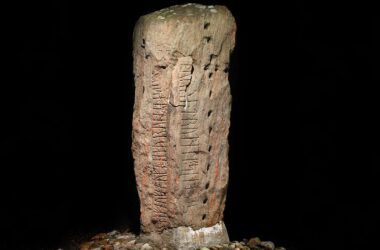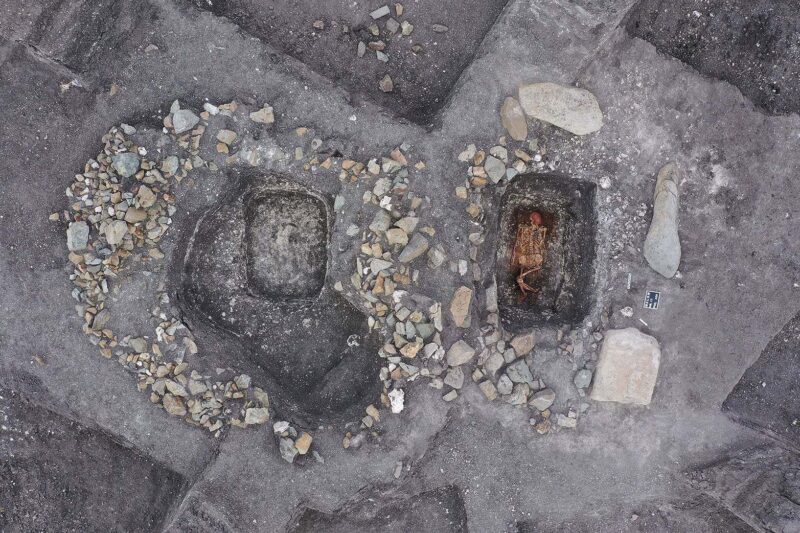A grave in Malomirovo, Bulgaria, containing a human skeleton bearing evidence of horse riding
Michał Podsiadło
Human skulls dating back to about 5,000 years ago in southeast Europe have yielded the first evidence of horse riding.
Nine men’s skeletons unearthed from tombs in Bulgaria, Hungary, and Romania display telltale signs of equestrian activity, including wear patterns on the spines, legs, and pelvises.
One of the most significant changes in human history is the widespread adoption of horseback riding, which facilitated livestock herding, facilitated trade and mobility, and ultimately altered the nature of conflict.
“Suddenly, people had the possibility to move five times as fast as they could move before and carry 10 times more than they were able to transport before – that’s revolutionary,” says Martin Trautmann of the University of Helsinki in Finland.
Livestock herders from the Eurasian steppe to the north of the Black Sea and the Caucasus Mountains have long been suspected of being the first humans to domesticate horses. These people are known as the Yamnaya. They then went on a killing spree that some archaeologists believe led to the colonisation of most of Europe.
Broken pieces of their pottery have shown traces of horse milk. Although this demonstrates that people kept horses, it is unknown when exactly people began using horses for transportation.
Trautmann’s group examined 217 skeletons from Bulgaria, Hungary, Romania, and Serbia for evidence of bone wear that would be consistent with equestrian activity. Somewhere between 3000 and 7000 years ago, they were created. “Bones are living tissue, and if you’re doing certain activities throughout your life, the attached muscles and ligaments exert pressure on the bones,” explains Volker Heyd, a team member and professor at the University of Helsinki.
Numerous characteristics, often seen in modern people who spend a lot of time on horseback, have been presented as hallmarks of horse riding. Some of these include vertebral wear from sitting on a horse, which affects both the top and bottom of the spine.
Heavy use of the thighs, perhaps due to the need to grip the horse with the legs, can be indicated by a thicker and rougher area where thigh muscles link to thigh bones. According to Trautmann, “the area where the ligament meets the bone becomes larger as a result of additional bone growth,” which allows for more even distribution of stress.
The team examined each skeleton for six such characteristics. There was the strongest evidence for horse riding in five people who exhibited five or more of the indicators. Four additional skeletons also displayed four of the symptoms. All nine were male and lived between 4500 and 5000 B.C.
Evidence of riding, such as bridle fragments, does not appear in the archaeological record from this region until around a thousand years later, according to William Taylor of the University of Colorado at Boulder. This part of the steppes is highlighted as a possible origin, although our dating is incorrect by nearly a millennium.
He argues that the bone wear patterns do not provide irrefutable evidence that the individuals were horse riders, since they may have been generated by anything else, such as riding in a cart driven by cattle. To quote, “We don’t have the kind of data I would like to see to let human skeletons track horse riding versus other activities.”
FAQs
Q1: What is the significance of the discovery of horseback riding evidence in human remains?
A1: The discovery marks the first evidence of horse riding dating back 5000 years ago in southeast Europe, indicating the widespread adoption of horseback riding in ancient civilizations.
Q2: What are the telltale signs of equestrian activity found in the human remains?
A2: The skeletons displayed wear patterns on the spines, legs, and pelvises, typical of individuals who spent significant time on horseback.
Q3: How did horseback riding impact human history?
A3: Horseback riding revolutionized human history, enabling faster movement, efficient livestock herding, trade facilitation, and altering the nature of conflicts.
Q4: Who were the Yamnaya people, and how are they connected to horse domestication?
A4: The Yamnaya people from the Eurasian steppe have long been suspected as the first humans to domesticate horses, and their migration may have led to the colonization of Europe.
Q5: What challenges arise in determining if the bone wear patterns truly indicate horse riding?
A5: While the bone wear patterns present characteristics of horseback riders, they do not provide conclusive evidence, as they might also be generated by other activities such as riding in carts driven by cattle.







